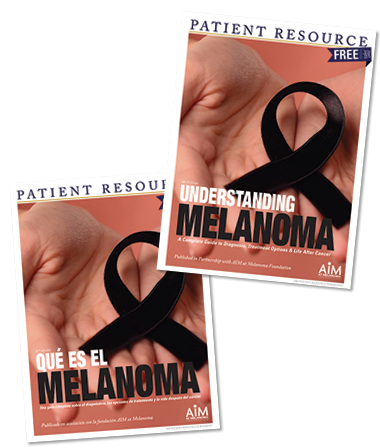
Melanoma
Glossary
Words to know: These definitions may help as you discuss your diagnosis and treatment with your health care team.
Cutaneous: Related to the skin.
Dermatologist: A doctor specially trained to diagnose and treat skin problems.
Dermis: The middle layer of the three main layers of the skin. The dermis has connective tissue, blood vessels, sebaceous (oil) and sweat glands, nerve endings, hair follicles and other structures.
Epidermis: The visible part of your skin; the thin, outermost layer that acts as a barrier to protect the body against infection, injury and the sun’s ultraviolet (UV) rays.
Hypodermis: The innermost of the three main layers of the skin, sometimes called subcutaneous tissue. It consists of fat, lymphatic vessels and connective tissue.
In-transit metastasis: A type of metastasis in which skin cancer spreads from the primary tumor through a lymphatic vessel and begins to grow in the lymphatic vessel before it has reached the nearest lymph node.
Lymphocyte: A type of immune cell (white blood cell) in lymph tissue and blood that helps the immune system fight infections and cancer. The main types are B-lymphocytes (B-cells) and T-lymphocytes (T-cells).
Melanocytes: A cell in the skin and eyes that produces and contains the pigment called melanin, which gives the skin its tan or brown color. Melanin protects the deeper layers of the skin from some harmful effects of the sun.
Microsatellite tumor: Cells that have spread very near the primary tumor that can be seen only with a microscope.
Pigment: A substance that gives color. In the body, the pigment melanin gives color to the skin, eyes and hair.
Progression-free survival: The length of time during and after treatment that a patient lives with the disease but it does not get worse.
Satellite tumor: A group of tumor cells in an area near the primary (original) tumor. In melanoma, satellite tumors occur close to the primary tumor (within 2 centimeters), on or under the skin, and can be seen without a microscope.
Sun protection factor (SPF): A rating scale for sunscreen products indicating how long the product provides protection against sunburn. The higher the SPF number, the more protection it provides.
Topical: Refers to medication applied to the skin or mucous membranes, usually as an ointment, cream, gel, etc.
Tumor microenvironment: The area that surrounds and sustains a tumor. It is made up of tumor cells, normal cells, immune cells and blood vessels.
Ultraviolet (UV) radiation: Invisible rays from the sun, tanning beds and sun lamps that can cause sunburn, premature aging of the skin, melanoma and other skin cancers and eye problems.
Some definitions courtesy of the website of the National Cancer Institute (www.cancer.gov)


